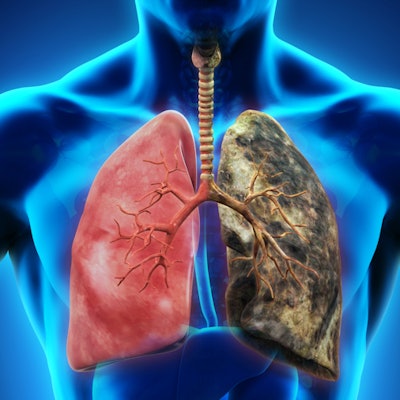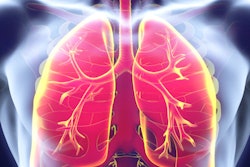
Despite the risks of ionizing radiation from CT lung cancer screening, cumulative exposure over a decade remains very low, along with the risk of developing cancer from screening. The benefits of lung screening thus outweigh any potential harms from radiation, concluded Italian researchers writing February 8 in BMJ.
Their analysis looked at a 10-year lung cancer screening study from Milan that examined high-risk smokers with more than 20 pack-years of smoking history. Based on a calculation of actual radiation dose, they found that the cumulative dose in the 10th year of screening was less than 10 mSv for men and 13 mSv for women, generating one radiation-induced major cancer for every 108 lung cancers that would be detected through screening (BMJ, February 8, 2017).
"In this study, we showed that the risk of cancer theoretically induced by radiation from CT screening is reasonably low, even after long-term exposure: After 10 years of low-dose CT screening in 5,203 asymptomatic high-risk patients ... we estimated that only 2.4 major cancers would be theoretically induced by radiation," wrote radiologist and lead investigator Dr. Cristiano Rampinelli from the European Institute of Oncology in an email to AuntMinnie.com.
The experience in more than 42,000 scans acquired for these individuals shows that radiation exposure from low-dose CT lung cancer screening "can be considered acceptable in light of the substantial mortality reduction associated with screening," the authors wrote.
Screening boosts survival
There are an estimated 200,000 new lung cancer cases a year in the U.S., along with a five-year overall survival rate of just 18%. Lung cancer screening with CT became a top priority for doctors and healthcare officials after the National Lung Screening Trial (NLST) in 2011 showed that screening can reduce lung cancer mortality by more than 20%. However, concerns remain that the exposure to ionizing radiation from screening could potentially increase the risk of developing cancer.
Only limited and controversial evidence of this risk can be found in the literature, but the question deserves more consideration particularly because in screening, radiation is delivered to healthy individuals, Rampinelli and colleagues wrote. And some previous studies have found a high risk of associated cancers.
For example, a 2012 study by Dr. David Brenner et al estimated that if even half of eligible smokers were screened, the number of associated lung cancers could reach 36,000, a nearly 2% increase over the number of cases without CT screening. Another study, this time by McCunney and Li, reported that smokers could expect to receive cumulative radiation exposure over 20 to 30 years of screening that exceeded the cumulative exposure of nuclear power plant workers and even atomic bomb survivors.
But these studies shouldn't be considered conclusive because they are based on an arbitrary radiation dose applied to all individuals being screened, the authors noted.
Therefore, they designed a study to retrospectively evaluate the cumulative radiation exposure and lifetime risk of cancer incidence associated with low-dose CT from a 10-year lung cancer screening program, using software to assist in the calculation of radiation exposure for each patient.
10 years of screening exams
Data for the study were retrospectively gathered and analyzed from the 10-year nonrandomized Continuous Observation of Smoking Subjects (COSMOS) trial, which scanned asymptomatic participants at high risk for lung cancer -- all over 50 years of age and with a smoking history of at least 20 pack-years. The 5,203 asymptomatic individuals (3,439 men, 1,764 women) underwent low-dose CT for 10 consecutive years in Milan, from 2004 to 2015.
Radiation doses were processed on radiation exposure tracking software (Radimetrics, Bayer HealthCare) that calculated organ doses. Patients were matched by age, sex, weight, and body habitus to 11 phantoms for men and women, creating size-specific organ doses that are more accurate than standard patient references on the software, the authors noted. The group then calculated cancer risks for each sex and organ based on the National Research Council's 2006 Biological Effects of Ionizing Radiation (BEIR) VII report.
The investigators calculated that over 10 years, their population of 5,203 individuals received 42,228 low-dose CT scans. They found a mean cumulative dose for the 10th year of screening of 9.3 mSv for men and 13.0 mSv for women.
Associated cancers rare
Based on the participants' age and sex, the lifetime attributable risk of lung cancer after 10 years of screening ranged from 5.5 to 1.4 cases per 10,000 men, and for major cancers from 8.1 to 2.6 per 10,000 people screened, the authors concluded.
In women ages 50 to 54, the lifetime attributable risk of lung cancer was fourfold higher and the risk of major cancers was threefold higher, compared with men ages 65 years and older.
"This difference is related to the increased radiosensitivity of women compared with men and to the risk of breast cancer associated with chest CT scans," the team wrote.
Summing it all up, the group estimated that 10 years of screening would induce 1.5 lung cancers and 2.4 major cancers, corresponding to an additional risk of induced major cancers of 0.05% (2.4/5,203). That compares to a total of 259 lung cancers that were diagnosed in 10 years of screening in their patient population.
"When we compared the number of lung cancers diagnosed after 10 years of CT screening with the number of theoretically induced cancers, we found that one radiation-induced major cancer would be expected for every 108 lung cancers detected through screening," Rampinelli said.
Based on the data, the cumulative dose over 10 years would amount to a single standard CT scan of the chest for men or a single abdominopelvic scan for women, the authors wrote.
"Furthermore, if we consider that the 10-year average dose from background sources in the U.S. is about 30 mSv, we can assume that 10 years of screening delivers only a third of the exposure to natural background radiation in the same period," they wrote.
Previous studies estimated higher exposure doses from CT screening with a consequent increased risk of cancer, Rampinelli noted. This is partially explained by the dose calculation method used, which didn't take into account important factors such as the patient's body size.
"Our research is the first where a specific dose has been calculated for each low-dose CT scan, overcoming the limitation of using a fixed radiation exposure for all participants and providing more accurate results," he said.
The authors acknowledged limitations of the BEIR VII report from which the information was derived. Critics in the scientific community claim that the report's conclusion that harms may be too small to be observed or nonexistent below 50 mSv lacks sufficient evidence to suggest that risk is nonexistent below a certain dose. But various authors suggest that the linear no-threshold (LNT) model follows a conservative approach and the inferred risk at lower doses probably overestimates the risk of cancer induction, they wrote.
"We believe this study is important for lung cancer screening, providing a quantitative risk based on exposure data," Rampinelli concluded. "Radiation exposure is a major concern in lung cancer screening and our results may help patients make informed decisions about CT screening, with the awareness that potential risks from radiation are overcome by substantial mortality reduction from screening."



















